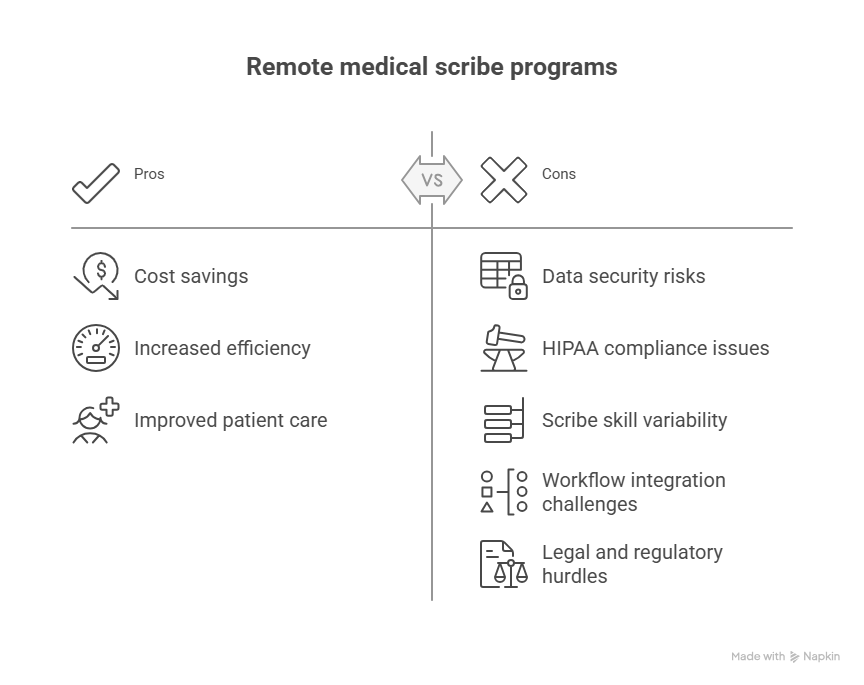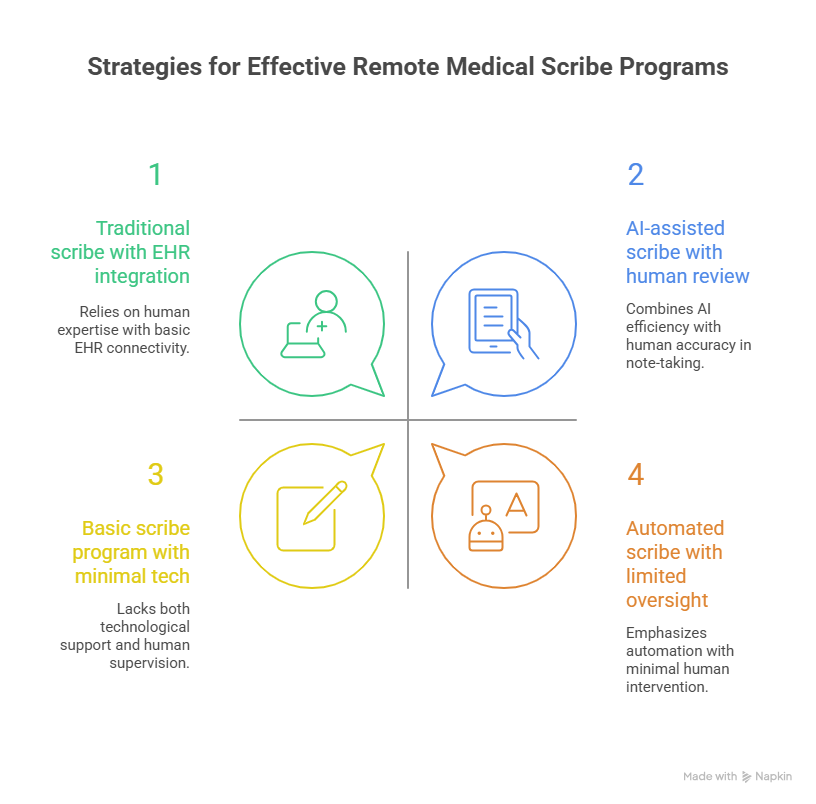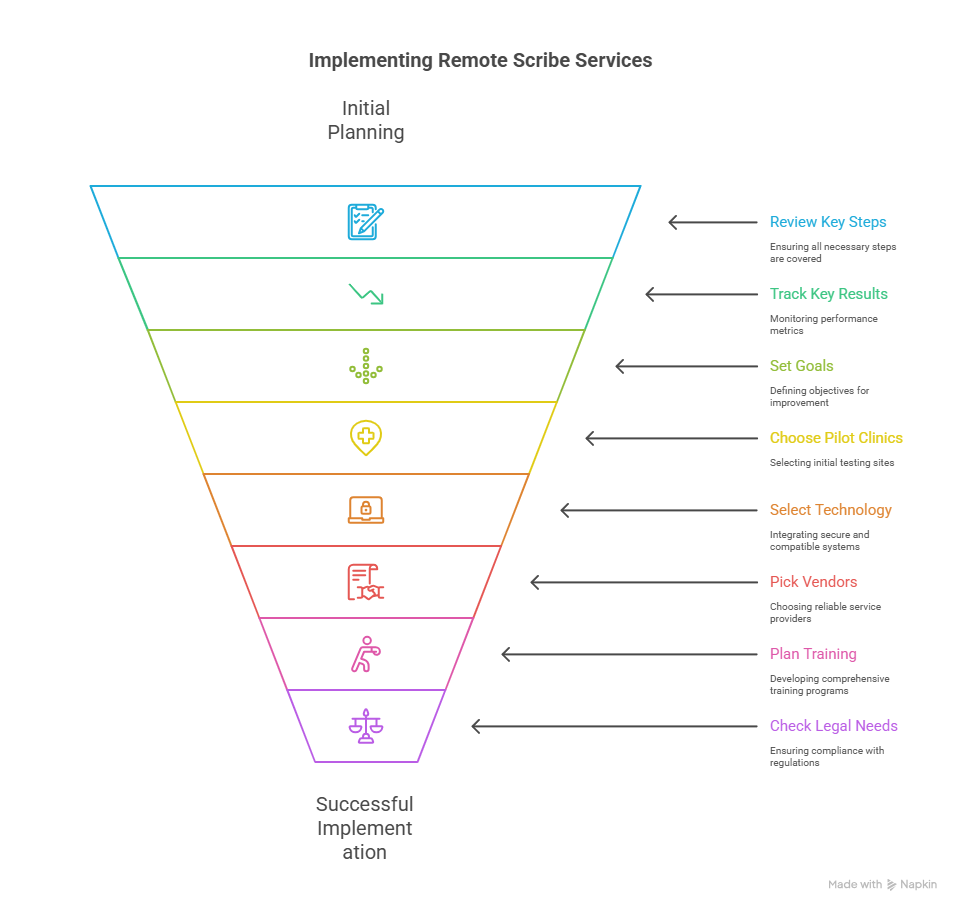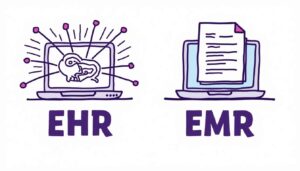Remote Medical Scribe: Roles, Benefits, and Best Practices
13 Aug 2025 By: Mary Dellosa
Updated

A remote medical scribe handles notes, codes, and admin tasks so doctors can focus on patients. This article covers roles, benefits, challenges, and workflows. It shares stats, examples, and advice for health systems thinking about using scribes.
A remote medical scribe gets trained in medical terms, EHR use, and privacy laws like HIPAA. They learn to note patient history, review systems, make plans, and list meds. They must know the difference between patient words and doctor thoughts. Many services use chart checks, feedback, and training to keep work accurate. Templates, shorthand, and chat tools help scribes stay clear and fast.
A remote medical scribe speeds up coding, flag to-dos, and help close charges faster. But groups must check for delays, tech issues, and legal rules. Out-of-state scribes need extra checks. When done right, scribes cut burnout, boost patient flow, and make records better. Ongoing checks and doctor review protect trust and safety. Tech and rules have grown with the field. HIPAA-safe tools and secure links help protect patient info. Clear roles, training, and KPIs track success. Groups can grow or shrink teams as needed, keeping control over training and quality.
Scribes ease doctor work and help handle messages. They sort inboxes, draft replies, and prep visit notes with past data. They must know the EHR and templates. Most use secure video or tools to stay synced with doctors in real time.
Quality checks are key to scribe work. Training, chart reviews, and feedback keep notes correct and private. Clear steps for unclear data help doctors fix issues fast. This keeps notes safe and full. Scribes log into EHRs with secure tools and strict access rules. Many use encrypted calls or chats to ask doctors for details. EHR links like note templates and billing fields support work like approvals and care tracking.
Benefits of hiring a Remote Medical Scribe for Clinicians
A remote medical scribe helps doctors by cutting chart time and stress. They let doctors spend more time with patients and less on paperwork. Doctors often see 25–40% less “pajama time.” This saved time helps improve work-life balance and lowers burnout risk. Scribes boost clinic output too. In primary and specialty care, they cut note delays and speed up visits. Some clinics see 10–30% more visits per day. Results vary by specialty and setup.
Trained scribes also make notes clearer and more complete. This helps with better coding and billing. Scribes who know the right templates capture all key visit parts. This cuts denials and adds value, helping justify scribe costs.
Doctors say patients feel more heard when notes don’t interrupt talks. Scribe systems protect privacy and let notes happen live. Audits and feedback help scribes stay sharp as rules and systems change.
Benefits for Patients and Care Quality
Patients feel visits are better when doctors focus on them, not screens. Studies show care feels more personal without doctors typing during talks. Better notes also help with care handoffs and long-term tracking.
A remote medical scribe helps manage group health by keeping records updated. Clean data supports outreach and reports. Good notes also boost reminders and cut missed care.
Benefits for Organizations and Revenue Cycle
A remote medical scribe helps save money through better output, coding, and lower doctor turnover. Clear notes help capture full pay, especially for complex billing.
A remote medical scribe often costs less than on-site ones. They can match busy times and train faster as a group. Many groups see ROI in months from faster visits and fewer claim issues.
Challenges and Risks when hiring a remote medical scribe

Remote medical scribe programs come with risks. Key issues include data safety, HIPAA rules, scribe skill levels, and workflow fit. Remote EHR use needs strong access rules, encrypted links, and trusted vendors. Scribes also need checks and privacy training.
Keeping quality high can be tough. Bad training can cause note errors and slowdowns. Some doctors may dislike sharing visits, especially for private topics. Success needs staff buy-in and good change plans.
Regulatory and Legal Considerations
Laws matter when using scribes. Groups must follow state rules, consent laws, and think about legal risks. Legal advice helps meet all rules. Some states limit where data is stored and who can see it. This can block sending scribe work overseas.
Best Practices when hiring a Remote Medical Scribe
Good remote medical scribe programs start with strong planning. A test run helps check tools, staff, and flow before full launch. Clear goals and metrics help track success. Getting doctors involved early builds support.
Templates and clear rules speed training and boost note quality. Written roles stop scribes from doing clinical work. Doctors must know they own the chart. Scribes just help with notes, not choices.

Training and Onboarding a remote medical scribe
Strong training is key. It must teach EHR use, terms, workflow, note rules, and privacy. Practice and shadowing help scribes learn fast. Ongoing checks keep quality high.
Tests before solo work help catch mistakes early. Training should match each specialty. ER scribes need different skills than heart clinic scribes.
Technology and Integration
Tech choices impact how well scribe programs work. Secure video and audio tools that link with the EHR make visits smoother. Voice tech can help, but it can’t replace trained scribes in complex cases.
Data access should be limited. Scribes must use their own logins for tracking. Use sign-on tools, role controls, and two-step checks. Encrypt data at all times. Vendor deals must cover breach alerts and who is liable.
Using AI and Automation Wisely
AI can speed up notes, fill fields, and suggest codes. But it may add wrong or made-up info. Pairing scribes with AI works best. Scribes check and fix AI drafts.
AI needs regular checks. Doctors must review all outputs to keep notes right. Human review keeps care safe and accurate.
Measuring Success: Key Performance Indicators
Programs should track key results in work, care, money, and satisfaction. Useful metrics include:
- Note error rates and how fast charts are done
- Time doctors spend on notes per patient or per day
- Visit count and how long each visit takes
- Money collected and how correct the codes are
- Doctor happiness and burnout levels
- Patient feedback on talks and visit quality
Training, Certification, and Career Paths for Scribes
As scribing grows, formal training and certificates are rising. Courses teach terms, EHRs, HIPAA, and note skills by specialty. Certificates prove skill and build trust. Some scribes move into clinical roles, while others stay and become experts in notes and coding.
Ongoing learning keeps scribes up to date on codes, rules, and tools. Mentors and paths to lead or QA jobs help keep talent and raise program quality.
Addressing Privacy and Security Concerns
Patient privacy comes first with remote scribes. Vendor contracts must cover strict privacy rules, checks, and HIPAA. For overseas scribes, laws must allow safe data use.
Key steps include logging all actions, giving limited data access, and letting doctors remove scribes if needed. Security checks and system tests cut cyber risks.
Specialty Considerations
Each specialty needs different notes. ERs need fast notes for time-based billing and busy flow. Behavioral health deals with private info, so scribe use may be limited. Surgery and GI need scribes who know how to write procedure notes.
Tailored templates and training boost scribe value. In complex fields, scribes with past clinical or admin work help improve notes and speed up training.
Real-World Examples and Case Studies
Many health systems see strong results from remote scribes. Clinics using scribes in telehealth improved doctor access and patient flow. ERs saw faster care and more doctor output when scribes handled notes.
One academic center saw less after-hours charting and better note quality after a pilot. A large group saw more visits and fewer code denials due to better note detail. These wins vary by site and goal.
Common Pitfalls and How to Avoid Them
Common issues include low doctor support, weak EHR fit, bad training, and unclear roles. Fix this by getting doctors involved early and using chart-friendly templates. Give strong training and clear rules on what scribes can and can’t do.
Many also overlook change planning. Starting a program needs clear talk, test runs, and steady feedback. A small group of doctor leaders can boost support and solve issues early.
The Future of Remote Scribing
The future may blend AI tools with human scribes. Better speech tech and data tools will boost speed. Scribes may shift to check and code notes, not just write them. As telehealth grows, scribes will stay key to remote care.
Remote work and spread-out teams will shape hiring. Rules on data may limit offshore work. The best setups will mix tech, people, and strong rules to keep notes safe, correct, and focused on the patient.
Checklist for Organizations Considering Remote Scribe Programs
Here is your rewritten text with the same number of sentences. Each sentence is short, clear, and simple.

Before launch, review key steps:
- Track key results: doctor time, visits, note quality, and satisfaction
- Set goals: save doctor time, boost billing, or raise quality?
- Pick pilot clinics or specialties to start with
- Choose tech that links to EHR, encrypts data, and controls access
- Pick vendors with checks, training, audits, and global data rules
- Plan training with role-based steps, skill checks, and ongoing reviews
- Check legal needs: HIPAA, state laws, and contract terms
Trending Now
Physician burnout in U.S. primary care has been rising, with Electronic Health Records (EHRs) identified as a major contributor due to documentation and clerical burdens, poor usability, high cognitive load, time demands, and rising volumes of electronic messaging. EHRs often shift administrative tasks to physicians, require excessive and sometimes redundant data entry, and feature inefficient, complex interfaces with low usability scores compared to other technologies. Information overload from bulky notes, alerts, and fragmented displays increases cognitive fatigue and risks critical information being missed. EHR use consumes significant portions of clinic time, reduces face-to-face patient interaction, and often extends into personal hours, disrupting work-life balance. Additionally, patient portals and secure messaging add to physicians’ workload without proportional compensation, with high message volumes strongly correlating to burnout. While EHRs can improve care coordination, prescribing safety, and data security, their current design and demands substantially exacerbate stress and dissatisfaction among physicians.
Conclusion
Remote scribes help solve note overload, burnout, and workflow gaps. With strong training, tech, privacy, and doctor input, they boost care and save costs. AI will grow, but human skill in capturing care details will stay key.
Groups that start slow, set clear goals, and invest in safety and training gain long-term value. This keeps care safe and notes accurate.
Ready to reduce charting time, improve accuracy, and ease clinician burnout? HelpSquad Health’s expert remote scribe services deliver trained professionals, secure tech, and proven results.
Talk to us today to learn how we can support your team.
FAQ
What are remote medical scribe services and how do they support clinicians?
Remote medical scribe services provide trained professionals who document patient visits, update the EHR, and handle administrative tasks from a distance. Whether the support comes from an online medical scribe or a medical scribe at home, the goal is to reduce charting time, improve accuracy, and help doctors focus on patients instead of paperwork. Many clinics use remote medical scribe services to decrease burnout and improve clinic flow.
Can someone really work as an online medical scribe or medical scribe at home?
Yes, many scribes now work fully remotely. An online medical scribe or a medical scribe at home can join visits through secure audio or video tools and enter notes directly into the EHR. Strong privacy protections, HIPAA-secure platforms, and role-based logins make this setup safe and efficient. Remote medical scribe services typically provide the tools and training needed for smooth, compliant remote workflows.
What makes someone the best virtual medical scribe for a practice?
The best virtual medical scribe is someone who understands medical terminology, EHR navigation, documentation rules, and specialty-specific workflows. They should write clearly, follow templates accurately, and communicate well with clinicians. Many organizations rely on remote medical scribe services because they include training, quality audits, and feedback loops that keep every online medical scribe consistent, accurate, and reliable.
How does hiring a medical scribe at home improve efficiency for clinics?
A medical scribe at home can take on charting, coding support, inbox management, and note preparation. These tasks often consume hours of a clinician’s day. Clinics using remote medical scribe services often report faster visit times, fewer note backlogs, and reduced after-hours “pajama time.” With the help of an online medical scribe or the best virtual medical scribe team, doctors can spend more time with patients and less time documenting.
How to become a virtual scribe, and what skills are required?
If you’re wondering how to become a virtual scribe, start by learning medical terminology, anatomy, HIPAA rules, and EHR basics. Many people train directly through remote medical scribe services, which provide structured onboarding and supervised charting practice. To become the best virtual medical scribe you can be, ongoing training, specialty-specific knowledge, and strong attention to detail are essential. Anyone exploring how to become a virtual scribe should look for programs that emphasize accuracy, privacy, communication, and flexible remote work skills.


